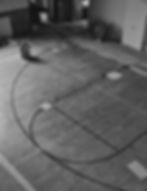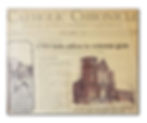Westminster Rises Again
- Tedd Long
- Jun 1, 2022
- 4 min read
Updated: Jun 27, 2022
The city’s oldest neighborhood is transforming—thanks partly to an exciting new project called "Gateway at Vistula."

If this building located at the intersection of Superior and Locust streets in Toledo’s Vistula Historic District could talk, it would begin its story in 1870 when 41 charter members of Westminster Presbyterian Church commissioned this massive brick structure for $47,000.

Construction of Westminster Church was completed in 1873 and the building was dedicated on February 1, 1874. However, this Gothic Revival house of worship was abandoned just 35 years later when the congregation merged with another Presbyterian church. In 1909 the building was sold to the St. John's Roman Catholic College.

Westminster Church then became known as Westminster Hall after a basketball court was installed in the sanctuary to replace a court set up earlier in the basement cafeteria of the college's main building on Superior and Walnut Streets. Basketball was king at St. John's, an all-male academy and university. The school was crowned the Middle West Non-Conference Champions in 1921. Westminster Hall hosted thousands of fans that year as the Knights enjoyed an undefeated season, including an impressive home win against Notre Dame and wins against other major Midwest schools, including the University of Michigan, the University of Detroit, and Dayton, St. Louis, and Carnegie Tech.

The Jesuits founded St. John's College in 1898 and initially opened the school in the Casey-Pomeroy house on Huron and Walnut Street, across the corner from Westminster Church. A large four-story brick school building was added next door in 1899 and expanded in 1909 (it was demolished in 1976). St. John's was a liberal arts college with a business administration program and a law school that served as the precursor to the University of Toledo College of Law. In May of 1936, the college portion of the school merged with the Toledo Teachers College. The new school was named De Sales College. It lasted just a few years before suspending operations at the onset of World War II. The Jesuits then purchased property near Gesu Parish, off Parkside and Bancroft, to build a new St. John's. However, in 1955, that land was used instead to construct St. Francis de Sales High School, sponsored by the Oblates of St. Francis de Sales. Eventually, the Jesuits re-established St. John's High School on Airport Highway as a college-prep school in 1965, so the St. John's story continues today. And so does the tale of Westminster Church.

After the demise of De Sales College, the Toledo Diocese took over this property and used Westminster Hall to host their Catholic Youth Organization (CYO) basketball and Golden Gloves boxing programs. The last CYO basketball games were played here in 2002. Then the building began to fall into serious disrepair until it was recently purchased by Fred Treuhaft, a lifelong Toledo resident with a dream of renovating historic Westminster Church and the surrounding neighborhood.

After more than a year of renovation, Treuhaft and his development partner, Blake Underwood, are still hard at work on Westminster.

The old basketball court remains, but the drop ceilings and other disguises used to redefine the church sanctuary as a college gymnasium more than a hundred years ago have been carefully removed.

The results are stunning. It’s impossible to enter the old sanctuary and not gaze up at its towering heights.

The wooden beams and embellishments in the high ceilings evoke a sense of awe and wonderment as you appreciate the grandeur of the old church.

Today, the building and its surrounding neighborhood are experiencing a transformation: from church to gymnasium—to a mix of office and retail space. All part of a multi-million-dollar, eight-building, mixed-use project called The Gateway at Vistula. This project is just one of several helping to revitalize the Vistula Historic District.

Vistula is Toledo's oldest residential neighborhood and home to many historic structures. Before Port Lawrence and Vistula agreed to join forces in 1833 and incorporate as Toledo in Michigan Territory, the two villages were known as "Upper Town" and "Lower Town," respectively, based on their locations along the Maumee River. Vistula was the more affluent of the two pioneer villages and is where some of Toledo's earliest founders called home. The waterfront neighborhood was known for its eclectic mix of grand homes and more modest middle-class residences. Today, with the addition of this project, along with other recent developments like Toledo Spirits, TolHouse, and the Lofts at Wonder Bread, Vistula is growing in stature again.

The old Westminster Church sanctuary is being converted into office space featuring an innovative mezzanine-style floor plan. The repurposed church will serve as a historical anchor for the 70,000-square-foot Gateway project—covering nearly a city block. Plans call for retail shops, restaurants, and a pedestrian walkway along Ostrich Lane featuring murals and new facades for the other buildings included in the development.
This mixed-use project is part of a growing trend in towns across the country. Thankfully, these new developments, driven by population growth and a renewed desire to live and work in walkable, urban neighborhoods, have spurred renovations of long-abandoned buildings like Westminster Church. Let's hope these trends endure and the energy and passion continue to grow so the Vistula Historic District and Toledo's other waterfront neighborhoods downriver from downtown can shine once again.